Canon Color imageCLASS MF9170c, Color imageCLASS MF9150c, Color imageCLASS MF8450c Operation Guide
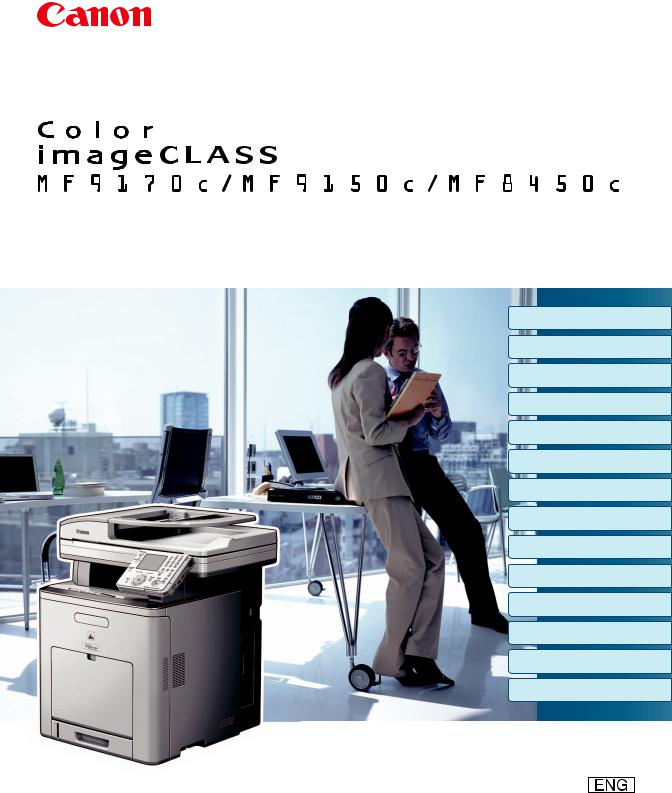
Basic Operation Guide
Before Using the Machine
Originals and Print Media
Registering Destinations in the Address Book
Copying
Fax
Printing
Scanning
Network
Setting from a PC
Maintenance
Troubleshooting
Machine Settings
Appendix
Please read this guide before operating this product.
After you finish reading this guide, store it in a safe place for future reference.
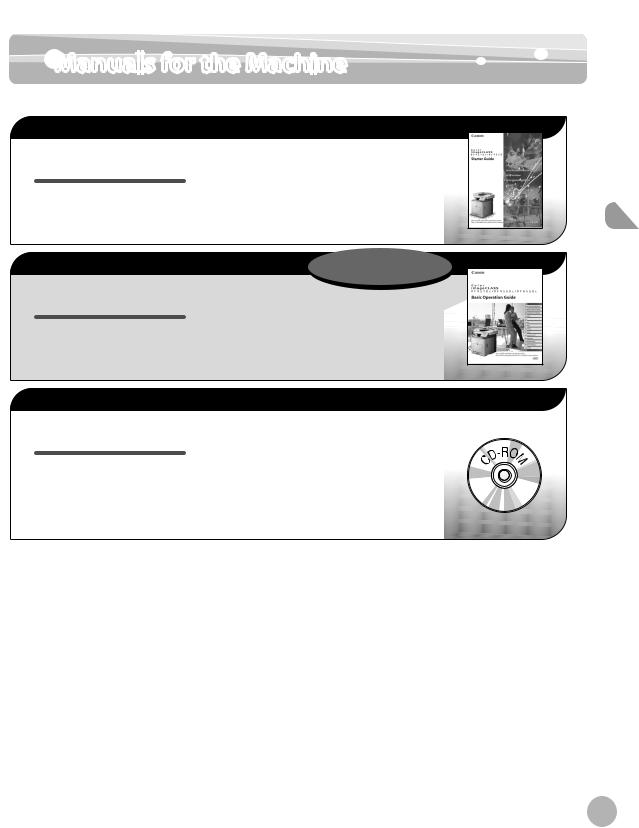
Manuals for the Machine
 Manuals for the Machine
Manuals for the Machine
The manuals for this machine are divided as follows. Please refer to them for detailed information.
Read this manual first.
Starter Guide
Read this manual to learn the required settings and connections before using the machine.
Read this manual next.
Basic Operation Guide
Read this manual to learn information about basic operations and machine functions.
●What you can do with the machine
●Machine setup
●Connection and settings before using the machine
●Connecting the machine to a network
●Software installation
This Document
●Safety instructions
●Registering destinations in the Address Book
●Copy
●Fax
●Specifications
Read the sections of these manuals that correspond to your intended use.
e-Manual
Read this manual to learn detailed information about advanced machine operations and functions, and how to customize machine settings.
(Located on User Software CD)
●Advanced features
●Scan
●Network
●Remote user interface
●Security
●Troubleshooting
●Considerable effort has been made to make sure that the manuals for the machine are free of inaccuracies and omissions. However, as we are constantly improving our products, if you need an exact specification, please contact Canon.
●The machine illustration on the cover may differ slightly from your machine.
Machine the for Manuals
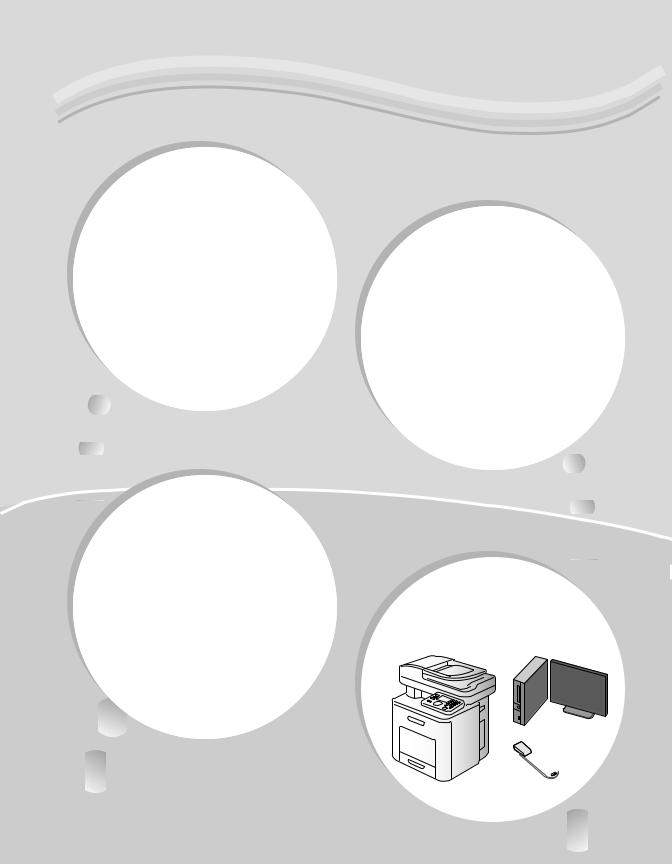
Functions Machine of Overview
Overview of Machine Functions
Depending on the system configuration and product purchased, some functions may not be available.
Copying
In addition to the Color and B/W copying, you can use various copy functions. 
Basic Operation Guide
Copying (see on p. 4-1)
e-Manual
Copying
Faxing
In addition to the normal faxing, you can send faxes from a computer and send I-faxes. 
Basic Operation Guide
Fax (see on p. 5-1) 
e-Manual





Fax
Printing
In addition to the printing from a computer, you can print a document directly from memory media.
Basic Operation Guide
Printing (see on p. 7-1)







 e-Manual
e-Manual 
Printing
Scanning
You can store the scanning documents to the computer, the file server and the USB memory.
USB memory. 
Basic Operation Guide
Scanning (see on p. 8-1)
p. 8-1)
 e-Manual
e-Manual 











Scanning
ii
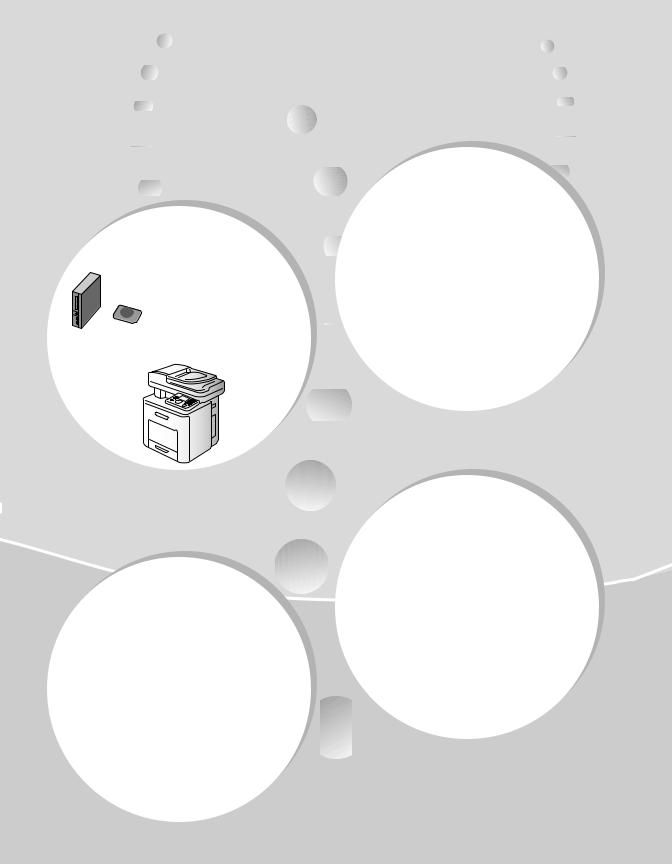
Network
This machine can be connected to a network. Connecting to a network enables
Connecting to a network enables you to use various functions.
you to use various functions.
Basic Operation Guide



Network (see on p. 9-1) e-Manual
Network Settings
Settings
E-mail function
Scanned documents can be sent as e- mail file attachments.
Basic Operation Guide
E-mail (see on p. 6-1)
e-Manual
Functions Machine of Overview
Remote User
Interface
You can set and manage this machine easily and quickly from a computer.
Basic Operation Guide
Operation Guide
Setting from a PC (see on p. 10-1) e-Manual
Setting from a PC
from a PC
Security function
You can limit the use of the machine by setting the IDs. You can also limit the use of some functions.





 e-Manual
e-Manual
Security
iii
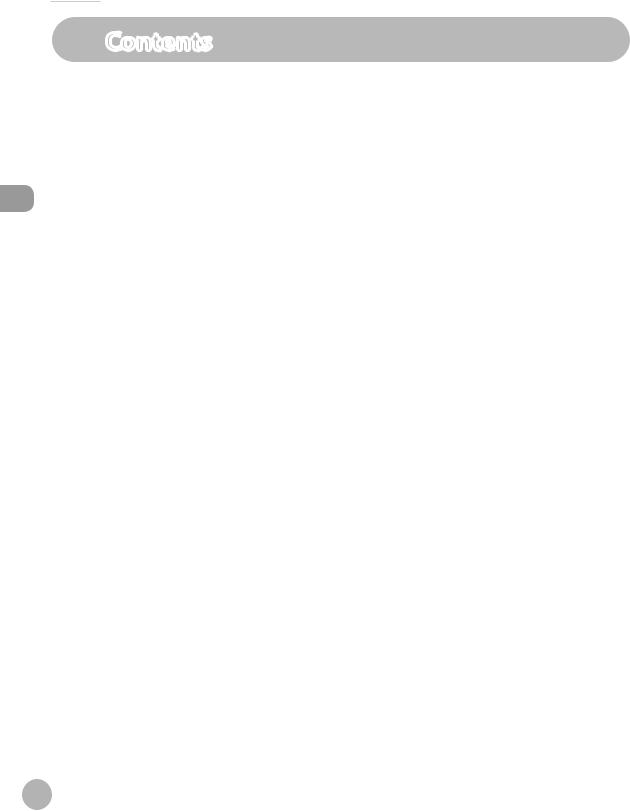
Contents
Contents
 Contents
Contents
Manuals for the Machine................................... |
i |
Overview of Machine Functions..................... |
ii |
Contents............................................................. |
iv |
Preface................................................................ |
ix |
Important Safety Instructions......................... |
ix |
Handling and Maintenance.............................. |
ix |
Location..................................................................... |
x |
Power Supply......................................................... |
xi |
Telephone Equipment....................................... |
xii |
Customer Support (U.S.A.)............................... |
xii |
Customer Support (Canada)........................... |
xii |
How to Use This Guide.................................. |
xiii |
Symbols Used in This Manual........................ |
xiii |
Keys and Buttons Used in This Manual....... |
xiii |
Illustrations Used in This Manual.................. |
xiv |
Legal Notices.................................................... |
xv |
IPv6 Ready Logo.................................................. |
xv |
Trademarks............................................................ |
xv |
Copyright............................................................... |
xv |
Third Party Software......................................... |
xvi |
Disclaimers........................................................... |
xvi |
About the Part Containing Mercury |
|
(Applicable Only to the USA)......................... |
xvi |
For CA, USA only................................................. |
xvi |
Legal Limitations on the Usage of Your |
|
Product and the Use of Images.................... |
xvii |
Users in the U.S.A......................................... |
xviii |
Pre-Installation Requirements for |
|
Canon Facsimile Equipment........................ |
xviii |
Connection of the Equipment....................... |
xix |
In Case of Equipment Malfunction.............. |
xix |
Rights of the Telephone Company.............. |
xix |
FCC Notice............................................................. |
xx |
Users in Canada.............................................. |
xxi |
Pre-Installation Requirements for |
|
Canon Facsimile Equipment.......................... |
xxi |
Notice.................................................................... |
xxii |
Laser Safety................................................... |
xxiv |
CDRH Regulations............................................ |
xxiv |
1 Before Using the Machine......... |
1-1 |
Machine Components................................... |
1-2 |
External View (Front)........................................ |
1-2 |
External View (Back)......................................... |
1-4 |
Internal View....................................................... |
1-5 |
Control Panel................................................... |
1-6 |
Main Control Panel........................................... |
1-6 |
Registering the Custom Keys........................ |
1-8 |
Left Side of the Control Panel..................... |
1-10 |
Right Side of the Control Panel.................. |
1-10 |
Display Parts and Functions...................... |
1-11 |
Main Menu Screen.......................................... |
1-11 |
Copy Top Screen.............................................. |
1-12 |
Send Type Selection Screen........................ |
1-13 |
Store Type Selection Screen........................ |
1-14 |
Select Memory Media Screen (Color |
|
imageCLASS MF9170c/9150c Only)......... |
1-14 |
Log In Mode...................................................... |
1-14 |
Toner Cartridges.......................................... |
1-15 |
Maintaining the Toner Cartridges............. |
1-16 |
Checking the Toner Level............................. |
1-17 |
Checking the Device Information............ |
1-18 |
Entering Characters.................................... |
1-19 |
Telephone Line Setting.............................. |
1-20 |
Timer Settings.............................................. |
1-22 |
Setting the Sleep Mode................................ |
1-22 |
Setting Auto Clear Time................................ |
1-23 |
Setting the Daylight Saving Time.............. |
1-24 |
2 Originals and Print Media......... |
2-1 |
Originals Requirements................................ |
2-2 |
Scanning Area................................................. |
2-3 |
Placing Originals............................................ |
2-4 |
iv

On the Platen Glass.......................................... |
2-4 |
In the Feeder....................................................... |
2-5 |
Paper Requirements...................................... |
2-7 |
Printable Area................................................. |
2-9 |
Loading Paper.............................................. |
2-10 |
In the Paper Drawer....................................... |
2-10 |
In the Stack Bypass Tray................................ |
2-15 |
Setting Paper Size and Type...................... |
2-20 |
For the Stack Bypass Tray............................. |
2-20 |
For the Paper Drawer..................................... |
2-22 |
Relationship between Original |
|
Orientation and Preprinted Paper |
|
Output Chart................................................ |
2-24 |
3 Registering Destinations in |
|
the Address Book...................... |
3-1 |
Storing/Editing Address Book..................... |
3-2 |
Registering Fax Numbers in the Address |
|
Book....................................................................... |
3-2 |
Registering E-Mail Addresses in the |
|
Address Book...................................................... |
3-7 |
Registering I-Fax Addresses in the |
|
Address Book.................................................... |
3-10 |
Registering File Server Addresses in |
|
the Address Book............................................ |
3-12 |
Registering Group Addresses in the |
|
Address Book.................................................... |
3-18 |
Checking/Editing Addresses Registered |
|
in the Address Book....................................... |
3-21 |
Erasing Addresses from the Address |
|
Book..................................................................... |
3-24 |
Storing/Editing One-Touch....................... |
3-26 |
Registering Fax Numbers in |
|
One-Touch......................................................... |
3-26 |
Registering E-Mail Addresses in |
|
One-Touch......................................................... |
3-31 |
Registering I-Fax Addresses in |
|
One-Touch......................................................... |
3-34 |
Registering File Server Addresses in |
|
One-Touch......................................................... |
3-37 |
|
Contents |
Registering Group Addresses in |
|
One-Touch......................................................... |
3-44 |
Checking/Editing Addresses Registered |
|
in One-Touch.................................................... |
3-47 |
Erasing Addresses Registered in |
|
One-Touch......................................................... |
3-50 |
4 Copying...................................... |
4-1 |
Overview of Copy Functions........................ |
4-2 |
Basic Copying Method.................................. |
4-4 |
Canceling Copy Jobs...................................... |
4-6 |
Selecting Color Mode.................................... |
4-7 |
Selecting Paper Source................................. |
4-9 |
Copying on Papers in Drawers..................... |
4-9 |
Using Stack Bypass Tray with Standard |
|
Paper Sizes......................................................... |
4-11 |
Using Stack Bypass Tray with Irregular |
|
Sizes of Paper.................................................... |
4-13 |
Using Stack Bypass Tray with |
|
Envelopes........................................................... |
4-15 |
Adjusting Density....................................... |
4-17 |
Adjusting Base Color...................................... |
4-19 |
2-Sided Copying.......................................... |
4-22 |
1 to 2-Sided Copying..................................... |
4-23 |
2 to 2-Sided Copying..................................... |
4-25 |
2 to 1-Sided Copying..................................... |
4-27 |
Enlarge/Reduce Images............................. |
4-30 |
Preset Zoom...................................................... |
4-30 |
Custom Copy Ratio......................................... |
4-32 |
Selecting Image Quality............................ |
4-34 |
Multiple Originals onto One Sheet |
|
(N on 1).......................................................... |
4-36 |
Adjusting Sharpness................................... |
4-39 |
Erasing Shadows/Lines.............................. |
4-41 |
Original Frame Erase...................................... |
4-42 |
Book Frame Erase............................................ |
4-45 |
Binding Erase.................................................... |
4-48 |
Adjusting Color Balance............................ |
4-51 |
Registering Color Balance............................ |
4-53 |
Recalling Registered Color Balance.......... |
4-55 |
Contents

Contents
Contents |
|
|
Deleting Color Balance................................. |
4-56 |
|
Collating Copies.......................................... |
4-57 |
|
Making Multiple Copies............................. |
4-59 |
|
Checking Current Settings........................ |
4-60 |
|
Frequently Used Settings (Mode |
|
|
Memory)........................................................ |
4-61 |
|
Registering Mode Memory.......................... |
4-61 |
|
Recalling Mode Memory.............................. |
4-63 |
|
Checking Mode Memory.............................. |
4-64 |
|
Deleting Mode Memory............................... |
4-65 |
|
Changing Standard Mode......................... |
4-66 |
|
Initializing Standard Mode........................ |
4-68 |
|
Checking and Canceling Copy Jobs/ |
|
|
Checking Copy Logs................................... |
4-69 |
|
Checking Copy Jobs....................................... |
4-69 |
|
Canceling Copy Jobs...................................... |
4-70 |
|
Checking Copy Logs...................................... |
4-71 |
|
5 Fax.............................................. |
5-1 |
Overview of Fax Functions........................... |
5-2 |
Introduction to Using Fax Functions.......... |
5-4 |
Methods for Receiving Faxes........................ |
5-4 |
Selecting the Receive Mode.......................... |
5-9 |
Setting the Current Date and Time........... |
5-12 |
Setting the Type of Telephone Line.......... |
5-13 |
Registering the Machine’s Name............... |
5-14 |
Registering Your Machine’s Fax |
|
Number............................................................... |
5-16 |
Sending Fax Documents............................ |
5-17 |
Basic Methods for Sending Faxes.............. |
5-17 |
Calling the Recipient before Sending |
|
Fax Documents (Manual Sending)............ |
5-19 |
Switching Temporarily to Tone Dialing... |
5-21 |
Dialing an Overseas Number (With |
|
Pauses)................................................................ |
5-22 |
Basic Methods for Sending I-Faxes........... |
5-25 |
Basic Methods for Sending PC Faxes....... |
5-27 |
Canceling Sending Fax Documents......... |
5-29 |
Specifying Destinations............................. |
5-30 |
Specifying a New Fax Number................... |
5-30 |
Using the Address Book................................ |
5-32 |
Using the One-Touch..................................... |
5-34 |
Using the Group Addresses......................... |
5-36 |
Sending Originals to More Than One |
|
Location (Broadcasting)................................ |
5-39 |
Selecting Resolution................................... |
5-41 |
Adjusting Density....................................... |
5-42 |
Manual Exposure Adjustment ................... |
5-42 |
Adjusting Base Color ..................................... |
5-43 |
Selecting Image Quality............................ |
5-45 |
2-Sided Original........................................... |
5-47 |
Sending Originals at a Preset Time |
|
(Delayed Sending)....................................... |
5-49 |
Direct Sending............................................. |
5-52 |
Favorites........................................................ |
5-54 |
Registering Favorites..................................... |
5-54 |
Erasing Favorites............................................. |
5-58 |
Using the Favorites......................................... |
5-61 |
Checking Settings for Recalled |
|
Favorites............................................................. |
5-62 |
Job Recall...................................................... |
5-64 |
ECM Transmission....................................... |
5-67 |
Adjusting the Pause Time.......................... |
5-69 |
Redialing Automatically When the Line |
|
Is Busy (Auto Redial)................................... |
5-71 |
Checking the Dial Tone before |
|
Sending......................................................... |
5-74 |
Standard Send Settings............................. |
5-76 |
Storing the Standard Send Settings......... |
5-76 |
Restoring the Standard Send Settings |
|
to Their Default................................................ |
5-78 |
Printing the TX Terminal ID ....................... |
5-80 |
Adjusting Sharpness................................... |
5-83 |
Specifying What to Display on the |
|
Screen for a Send Operation..................... |
5-85 |
Restoring the Send Function Settings |
|
to Their Default............................................ |
5-87 |
Send Start Speed......................................... |
5-89 |
Printing Received Documents on Both |
|
Sides of Paper.............................................. |
5-91 |
vi

Reducing a Received Document.............. |
5-93 |
Printing Footer Information on a |
|
Received Document.................................... |
5-96 |
Specifying the Way of Printing When |
|
Toner Is Low.................................................. |
5-98 |
ECM Reception........................................... |
5-100 |
Setting the Incoming Ring Tone............. |
5-102 |
Receiving Documents Manually with |
|
an External Telephone (Remote |
|
Reception).................................................. |
5-104 |
Activating the Remote Reception.......... |
5-104 |
Receiving Documents with the |
|
Remote Reception....................................... |
5-105 |
Adjusting the Auto Switch Time for |
|
the Manual RX Mode................................ |
5-106 |
Rejecting Incoming Faxes from the |
|
Unidentified Senders................................ |
5-108 |
Receive Start Speed.................................. |
5-110 |
Receiving Documents in Memory |
|
without Printing Out (Memory Lock |
|
Reception).................................................. |
5-112 |
Printing All Documents Stored in the |
|
Memory Lock Reception Mode............... |
5-115 |
Forwarding Received Fax Documents... |
5-117 |
Specifying Forwarding Settings............. |
5-117 |
Sending Documents in Memory to a |
|
Different Destination.................................. |
5-129 |
Handling Documents with |
|
Forwarding Errors........................................ |
5-131 |
Resending Documents with |
|
Forwarding Errors........................................ |
5-133 |
Checking/Changing the Status of |
|
Documents with Forwarding Errors...... |
5-135 |
Checking/Changing the Status of Fax |
|
Documents in Memory............................ |
5-138 |
Checking/Deleting Fax Transmission |
|
Documents..................................................... |
5-138 |
Checking/Deleting Fax Reception |
|
Documents..................................................... |
5-140 |
Checking/Printing the Fax Log................ |
5-141 |
Contents
6 E-mail.......................................... |
6-1 |
Overview of E-Mail Functions...................... |
6-2 |
Introduction to Using E-Mail Functions..... |
6-4 |
Basic E-Mail Operations................................ |
6-5 |
Sending E-Mail Documents........................... |
6-5 |
Canceling Sending E-Mail Documents...... |
6-7 |
7 Printing...................................... |
7-1 |
Overview of Print Functions......................... |
7-2 |
Introduction to Using Print Functions....... |
7-4 |
Printing Documents from Computer.......... |
7-5 |
Scaling Documents........................................ |
7-7 |
Printing Multiple Pages on One Sheet....... |
7-9 |
2-Sided Printing........................................... |
7-10 |
Printing from Memory Media (Direct |
|
Print).............................................................. |
7-11 |
Memory Media Supported by This |
|
Machine.............................................................. |
7-11 |
Data Supported by This Machine.............. |
7-12 |
Inserting Memory Media.............................. |
7-13 |
Removing Memory Media........................... |
7-14 |
Printing from Memory Media..................... |
7-14 |
Checking and Canceling Print Jobs/ |
|
Checking Print Logs.................................... |
7-27 |
Checking Print Jobs........................................ |
7-27 |
Canceling Print Jobs....................................... |
7-28 |
Checking Print Logs....................................... |
7-29 |
8 Scanning.................................... |
8-1 |
Overview of Scanner Functions................... |
8-2 |
Introduction to Using Scanner |
|
Functions......................................................... |
8-4 |
For Scanning Documents to a File |
|
Server.................................................................... |
8-4 |
For Scanning Documents from a |
|
Networked Computer..................................... |
8-4 |
Basic Scanning Operations........................... |
8-5 |
Scanning Documents to a File Server........ |
8-5 |
Scanning Documents to a USB Memory. |
. 8-7 |
Contents
vii

Contents
Contents |
|
Scanning Documents from a |
|
Networked Computer..................................... |
8-9 |
9 Network...................................... |
9-1 |
Flowchart for Setting Up Network.............. |
9-2 |
What is the Network?.................................... |
9-3 |
Overview of Network Functions.................. |
9-4 |
10 Settings from a PC................. |
10-1 |
Overview of Remote UI.............................. |
10-2 |
Starting the Remote UI.............................. |
10-4 |
11 Maintenance.......................... |
11-1 |
Cleaning the Machine................................ |
11-2 |
Exterior................................................................ |
11-2 |
Interior................................................................ |
11-3 |
Scanning Area.................................................. |
11-4 |
Replacing the Toner Cartridges................ |
11-7 |
When a Message Appears............................ |
11-7 |
Replacing the Toner Cartridge with a |
|
New One............................................................. |
11-8 |
Recycling Used Cartridges....................... |
11-13 |
The Clean Earth Campaign....................... |
11-13 |
U.S.A. PROGRAM........................................... |
11-14 |
CANADA PROGRAM-CANADA |
|
PROGRAMME................................................. |
11-17 |
Transporting the Machine....................... |
11-19 |
12 Troubleshooting.................... |
12-1 |
Clearing Jams............................................... |
12-2 |
Original Jams.................................................... |
12-3 |
Paper Delivery Tray......................................... |
12-5 |
Duplex Unit....................................................... |
12-6 |
Stack Bypass Tray............................................ |
12-8 |
Paper Drawer 1.............................................. |
12-10 |
Optional Paper Drawer (Paper |
|
Drawer 2)......................................................... |
12-11 |
Inside of the Machine................................. |
12-13 |
Fixing Unit....................................................... |
12-16 |
Back Cover...................................................... |
12-18 |
When the Message Does Not |
|
Disappear................................................... |
12-19 |
If the Delivery Feeder Unit Is Not |
|
Installed Correctly..................................... |
12-22 |
Error Messages.......................................... |
12-25 |
Error Codes................................................. |
12-30 |
If <Set the correct paper. > is |
|
displayed.................................................... |
12-36 |
Reloading the Paper.................................... |
12-36 |
Changing the Paper Size Setting............ |
12-36 |
If a Power Failure Occurs.......................... |
12-39 |
If You Cannot Solve a Problem................ |
12-40 |
Customer Support (U.S.A.)........................ |
12-40 |
Customer Support (Canada).................... |
12-40 |
13 Machine Settings................... |
13-1 |
Machine Settings......................................... |
13-2 |
Printing USER’S DATA LIST........................... |
13-2 |
Accessing the Setting Menu....................... |
13-3 |
Setting Menu............................................... |
13-5 |
Paper Settings.................................................. |
13-5 |
Volume Settings.............................................. |
13-6 |
Common Settings........................................... |
13-6 |
Communications Settings........................... |
13-8 |
Address Book Settings............................... |
13-11 |
Printer Settings............................................. |
13-13 |
Timer Settings............................................... |
13-17 |
Adjustment/Cleaning................................. |
13-18 |
Report Settings............................................. |
13-19 |
System Management Settings................ |
13-19 |
14 Appendix............................... |
14-1 |
Specifications............................................... |
14-2 |
Index.............................................................. |
14-7 |
viii
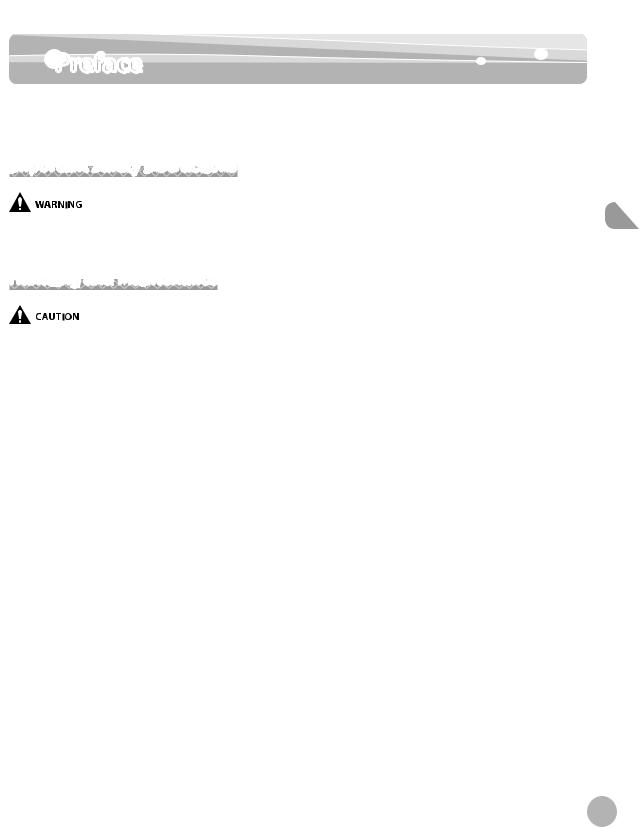
Preface
 Preface
Preface
Thank you for choosing a Canon product. Before using the machine, please read the following instructions for your safety.
Important Safety Instructions
Except as specifically described in this guide, do not attempt to service the machine yourself. Never attempt to disassemble the machine: opening and removing its interior covers will expose you to dangerous voltages and other risks. For all service, contact your local authorized Canon dealer.
Handling and Maintenance |
Be careful when removing printed paper from output trays or when aligning it, because it may be hot and result in burn injury.
–Follow all warnings and instructions marked on the machine.
–Do not subject the machine to strong physical shocks or vibrations.
–Always unplug the machine before moving or cleaning it.
–To avoid paper jams, never unplug the power cord, open the left cover or add or remove paper in the machine while printing.
–When transporting the machine, be sure to remove the toner cartridge from the machine.
–Place the toner cartridge in its original protective bag or wrap it in a thick cloth to prevent exposure to light.
–Always use the hand grips (on the left and right side) of the machine when you lift the machine. Never lift the machine by any of its trays or attachments.
–Do not insert any objects into the slots or openings on the machine since they may touch dangerous voltage points or short out parts. This could result in fire or electric shock.
–Do not allow small objects (such as pins, paper clips, or staples) to fall into the machine.
–To avoid spillage in or around the machine, do not eat or drink near it.
–Keep the machine clean. Dust accumulation can prevent the machine from operating properly.
–Toner cartridge for this machine will be available for at least seven (7) years (or any such longer period as required by applicable laws) after production of this machine model has been discontinued.
–Turn off the main power switch and unplug the power cord from the wall outlet and contact your local authorized Canon dealer in any of the following cases:
•When the power cord or plug is damaged or frayed.
•If liquid or small object has fallen into the machine.
•If the machine has been exposed to rain or water.
•If the machine does not operate normally when you have followed the instructions in this guide.
Preface
ix

Preface
Preface
•Adjust only those controls that are covered by the instructions in this guide. Improper adjustment of other controls may result in damage and may require extensive work by a qualified technician to restore the product to normal operation.
•If the machine has been dropped.
•If the machine exhibits a distinct change in performance, indicating a need for servicing.
–Do not place your hands, hair, clothing, etc., near the exit and feed rollers. Even if the machine is not in operation, your hands, hair, or clothing may get caught in the rollers, which may result in personal injury or damage if the machine suddenly starts printing.
–Be careful when removing printed paper from paper delivery tray or when aligning it, because it may be hot and result in burn injury.
Location
–Place the machine on a flat, stable, vibration-free surface that is strong enough to support its weight.
–Place the machine in a cool, dry, clean, well ventilated place.
–Make sure the area is free from dust.
–Make sure the location is not exposed to high temperature or humidity.
–Keep the machine away from direct sunlight as this can damage it. If you have to place the machine near a window, install heavy curtains or blinds.
–Do not use the machine near water. Make sure that no wet or humid objects come into contact with the machine.
–Do not use or store the machine outdoors.
–Do not place the machine near devices that contain magnets or generate magnetic fields, such as speakers.
–If possible, place the machine near an existing telephone line outlet for easy connection of the telephone line cord, and to avoid the expense of installing a new outlet.
–Place the machine near a standard 120 V AC (60 Hz) power outlet.
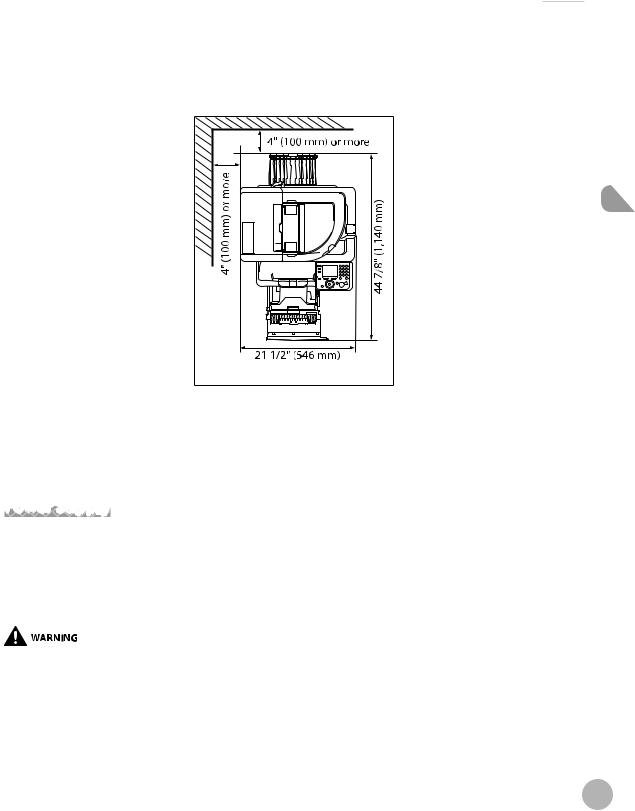
Preface
–To ensure reliable operation of the machine and to protect it from overheating (which can cause it to operate abnormally and create a fire risk), do not block the exhaust vent. Never block or cover any openings on the machine by placing it on a bed, sofa, rug, or other similar surface. Do not place the machine in a cupboard or built-in installation, or near a radiator or other heat source unless proper ventilation is provided. Leave at least 4" (100 mm) around all sides of the machine.
Preface
–Do not stack boxes or furniture around the power outlet. Keep the area free so you can reach the outlet quickly. If you notice anything unusual (smoke, strange odors, noises) around the machine, unplug the power cord immediately. Contact Canon Customer Care Center.
–Do not allow anything to rest on the power cord, and do not place the machine where the cord will be walked on. Make sure the cord is not knotted or kinked.
Power Supply
–During electrical storms, turn off the main power switch and unplug the power cord from the power outlet. (Please note that any data stored in the memory, including received fax documents, will be deleted about 60 minutes after you turn off the main power switch or unplug the power cord.)
–Whenever you turn off the main power switch, wait at least five seconds before you turn it on again.
–Do not plug the power cord into an uninterruptible power supply (UPS).
This product emits low level magnetic flux. If you use a cardiac pacemaker and feel abnormalities, please move away from this product and consult your doctor.
xi

Preface
Preface
Telephone Equipment |
When using telephone equipment, basic safety precautions should always be followed to reduce the risk of fire, electric shock, and injury to persons, including the following:
1.Do not use this machine near water (i.e., near a bathtub, kitchen sink, or laundry tub), or in a wet basement or near a swimming pool.
2.Avoid using the telephone during an electrical storm, as there may be a remote risk of electric shock from lightning.
3.Do not use the telephone to report a gas leak in the vicinity of the leak.
Customer Support (U.S.A.)
Your machine is designed with the latest technology to provide trouble-free operation. If you encounter a problem with the machine’s operation, try to solve it by using the information in Chapter 12. If you cannot solve the problem or if you think your machine needs servicing, contact Canon Customer Care Center at 1- 800-828-4040 between the hours of 8:00 A.M. to 8:00 P.M. EST for U.S.A. and 9:00 A.M. to 8:00 P.M. EST for Canada Monday through Friday and 10:00 A.M. to 8:00 P.M. on Saturday. On-line support for 24 hours is also available at the website.
http://www.canontechsupport.com/
Customer Support (Canada)
Canon Canada Inc., offers a full range of customer technical support options*:
–For step-by-step troubleshooting, e-mail technical support, the latest driver or document downloads, and answers to frequently asked questions, visit http://www.canon.ca/
–Free live technical support 9 A.M. to 8 P.M. EST Monday through Friday (excluding holidays) for products still under warranty 1-800-652-2666
–For the location of the authorized service facility nearest you, visit http://www.canon.ca/ or 1-800-652-2666
–If the problem cannot be corrected by using one of the above technical support options, repair options are available at the time of your call to the live technical support number above or via the website at http://
www.canon.ca/
* Support program specifics are subject to change without notice.
xii
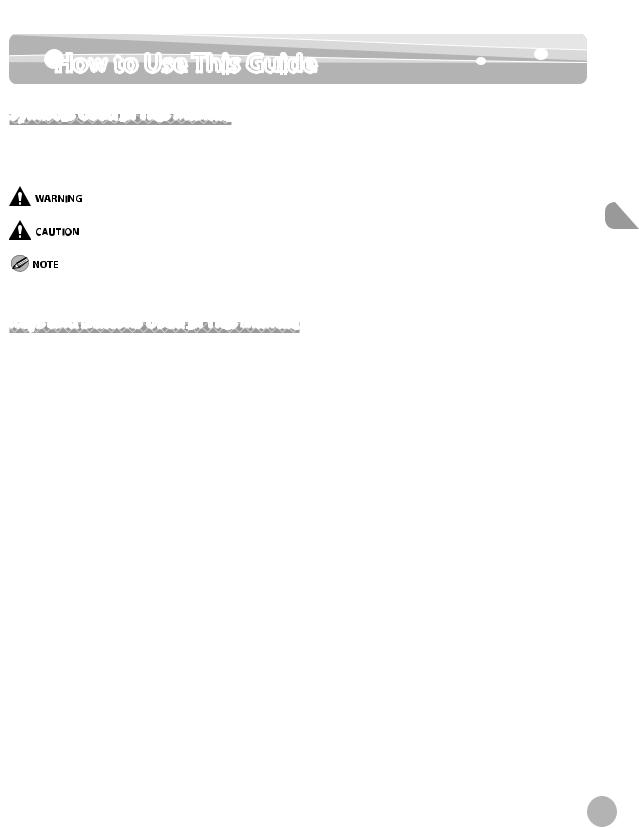
How to Use This Guide
 How to Use This Guide
How to Use This Guide
Symbols Used in This Manual
The following symbols are used throughout the manuals for the machine and indicate the warnings, cautions and notes you should keep in mind when using the machine.
Indicates a warning that may lead to death or serious injury if not observed.
Explains how to avoid actions that could injure you or damage your machine.
Explains operating restrictions and how to avoid minor difficulties.
Keys and Buttons Used in This Manual
The following symbols and key names are a few examples of how keys and buttons to be pressed are expressed in this manual.
–Operation Panel Keys: <Key icon> + (Key name) Example:  (Stop).
(Stop).
–Buttons on the computer operation screen: [Button name] Example: [OK]
Information in the display appears in angle brackets: <Load paper.>.
Guide This Use to How
xiii
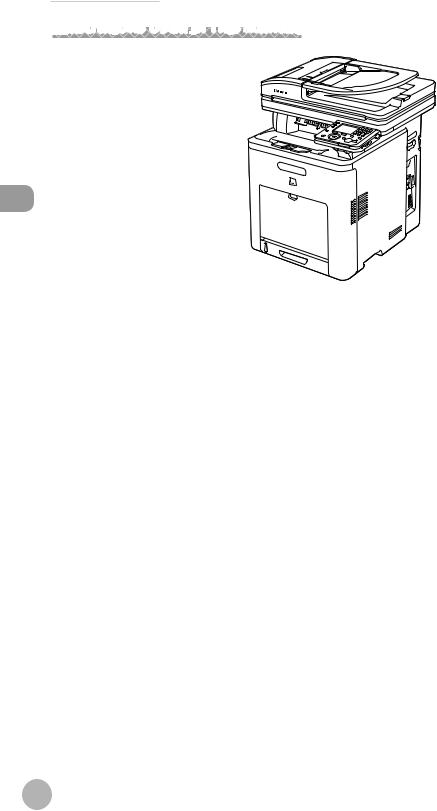
Guide This Use to How
How to Use This Guide
Illustrations Used in This Manual
Illustrations used in this manual are the model Color imageCLASS MF9170c (with no optional equipment). When there is any difference among Color imageCLASS MF9170c, Color imageCLASS MF9150c and Color imageCLASS MF8450c, it is clearly indicated in the text, e.g., ”Color imageCLASS MF9170c Only.”
xiv
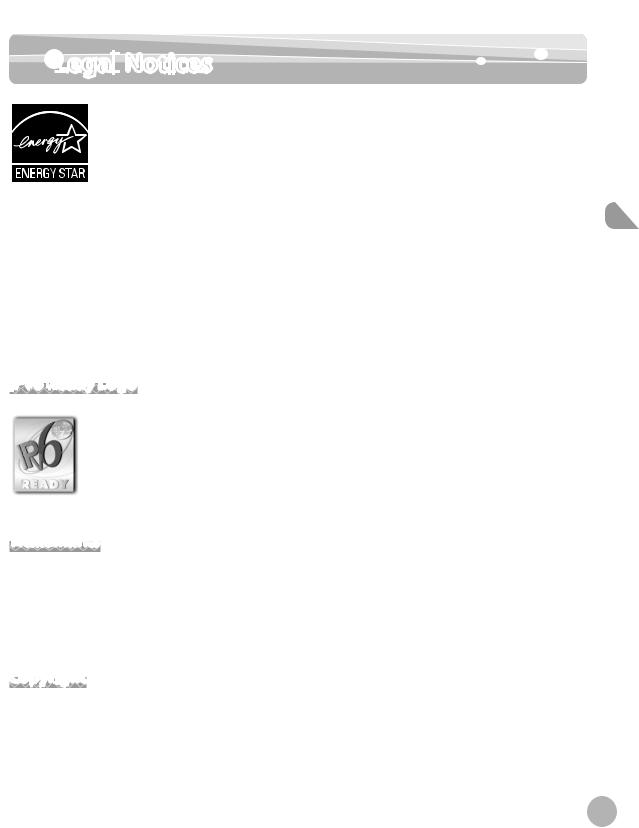
Legal Notices
 Legal
Legal
 Notices
Notices
As an ENERGY STAR Partner, Canon U.S.A., Inc. has determined that this product meets the ENERGY STAR Program for energy efficiency.
The International ENERGY STAR Office Equipment Program is an international program that promotes energy saving through the use of computers and other office equipment.
The program backs the development and dissemination of products with functions that effectively reduce energy consumption. It is an open system in which business proprietors can participate voluntarily.
The targeted products are office equipment, such as computers, displays, printers, facsimiles, and copiers. The standards and logos are uniform among participating nations.
IPv6 Ready Logo
The protocol stack included in this machine has obtained the IPv6 Ready Logo Phase-1 established by the IPv6 Forum.
Trademarks
Canon, the Canon logo, Color imageRUNNER, and imageWARE are trademarks of Canon Inc.
Microsoft, Windows, Windows Server and Windows Vista are trademarks or registered trademarks of Microsoft Corporation in the U.S. and/or other countries.
All other product and brand names are registered trademarks, trademarks or service marks of their respective owners.
Copyright
Copyright © 2008 by Canon Inc. All rights reserved. No part of this publication may be reproduced, transmitted, transcribed, stored in a retrieval system, or translated into any language or computer language in any form or by any means, electronic, mechanical, magnetic, optical, chemical, manual, or otherwise, without the prior written permission of Canon Inc.
UFST: Copyright © 1989-2003 Monotype Imaging, Inc.
Notices Legal
xv
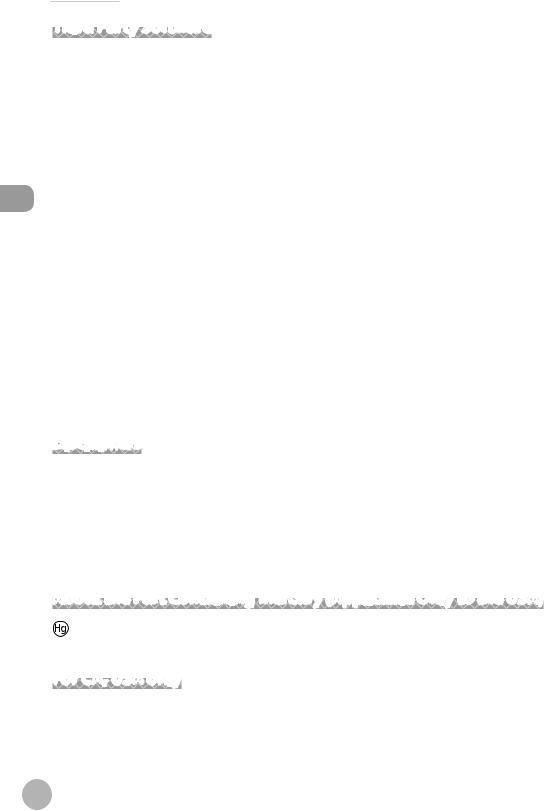
Legal Notices
|
Third Party Software |
|
|
This product includes software and/or software modules that are licensed by third parties (LICENSORS). Use |
|
|
and distribution of this software and/or software modules (the “SOFTWARE”) are subject to conditions (1) |
|
|
through (9) below. |
|
|
(1) You agree that you will comply with any applicable export control laws, restrictions or regulations of the |
|
|
countries involved in the event that the SOFTWARE is shipped, transferred or exported into any country. |
|
|
(2) LICENSORS retain in all respects the title, ownership and intellectual property rights in and to the |
|
|
SOFTWARE. Except as expressly provided herein, no license or right, expressed or implied, is hereby conveyed |
|
|
or granted by Canon’s licenser to you for any intellectual property of LICENSORS. |
|
|
(3) You may use the SOFTWARE solely for use with the Canon product you purchased (the “PRODUCT”). |
|
Legal |
(4) You may not assign, sublicense, market, distribute, or transfer the SOFTWARE to any third party without |
|
prior written consent of Canon and LICENSORS. |
||
Notices |
||
(5) Notwithstanding the foregoing, you may transfer the SOFTWARE only when (a) you assign all of your rights |
||
|
||
|
to the PRODUCT and all rights and obligations under the conditions to transferee and (b) such transferee |
|
|
agrees to be bound by all these conditions. |
|
|
(6) You may not decompile, reverse engineer, disassemble or otherwise reduce the code of the SOFTWARE to |
|
|
human readable form. |
|
|
(7) You may not modify, adapt, translate, rent, lease or loan the SOFTWARE or create derivative works based on |
|
|
the SOFTWARE. |
|
|
(8) You are not entitled to remove or make separate copies of the SOFTWARE from the PRODUCT. |
|
|
(9) The human-readable portion (the source code) of the SOFTWARE is not licensed to you. |
|
|
Disclaimers |
|
|
The information in this document is subject to change without notice. |
|
|
CANON INC. MAKES NO WARRANTY OF ANY KIND WITH REGARD TO THIS MATERIAL, EITHER EXPRESS OR |
|
|
IMPLIED, EXCEPT AS PROVIDED HEREIN, INCLUDING WITHOUT LIMITATION, THEREOF, WARRANTIES AS TO |
|
|
MARKETABILITY, MERCHANTABILITY, FITNESS FOR A PARTICULAR PURPOSE OF USE OR NON-INFRINGEMENT. |
|
|
CANON INC. SHALL NOT BE LIABLE FOR ANY DIRECT, INCIDENTAL, OR CONSEQUENTIAL DAMAGES OF ANY |
|
|
NATURE, OR LOSSES OR EXPENSES RESULTING FROM THE USE OF THIS MATERIAL. |
|
|
About the Part Containing Mercury (Applicable Only to the USA) |
|
|
LAMP(S) INSIDE THIS PRODUCT CONTAIN MERCURY AND MUST BE RECYCLED OR DISPOSED OF |
|
|
ACCORDING TO LOCAL, STATE OR FEDERAL LAWS. |
|
|
For CA, USA only |
|
|
Included battery contains Perchlorate Material - special handling may apply. |
|
|
See http://www.dtsc.ca.gov/hazardouswaste/perchlorate/ for details. |
xvi
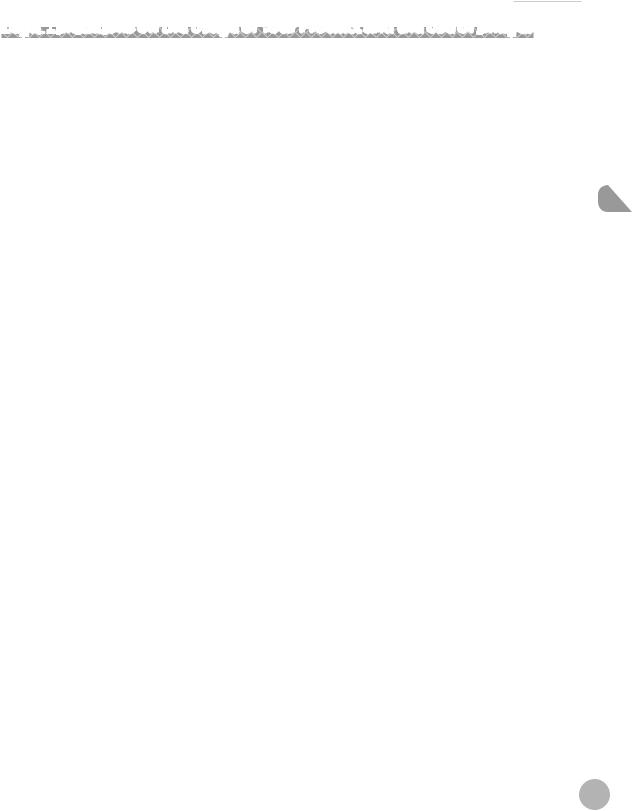
Legal Notices
Legal
 Limitations on the Usage of Your Product and the Use of Images
Limitations on the Usage of Your Product and the Use of Images
Using your product to scan, print or otherwise reproduce certain documents, and the use of such images as scanned, printed or otherwise reproduced by your product, may be prohibited by law and may result in criminal and/or civil liability.
A non-exhaustive list of these documents is set forth below. This list is intended to be a guide only. If you are uncertain about the legality of using your product to scan, print or otherwise reproduce any particular document, and/or of the use of the images scanned, printed or otherwise reproduced, you should consult in advance with your legal advisor for guidance.
– Paper Money |
– Travelers Checks |
– Money Orders |
– Food Stamps |
– Certificates of Deposit |
– Passports |
– Postage Stamps (canceled or uncanceled) |
– Immigration Papers |
– Identifying Badges or Insignias |
– Internal Revenue Stamps (canceled or |
|
uncanceled) |
– Selective Service or Draft Papers |
– Bonds or Other Certificates of Indebtedness |
– Checks or Drafts Issued by Governmental |
– Stock Certificates |
Agencies |
|
– Motor Vehicle Licenses and Certificates of Title |
– Copyrighted Works/Works of Art without |
|
Permission of Copyright Owner |
Notices Legal
xvii

Users in the U.S.A.
 Users in the U.S.A.
Users in the U.S.A.
Pre-Installation Requirements for Canon Facsimile Equipment |
A. |
Location |
||
|
Supply a suitable table, cabinet, or desk. See p. 14-2 for the machine’s weight and dimensions. |
||
B. |
Order Information |
||
Users |
1. |
Only a single line, touch-tone or rotary telephone set is to be used. |
|
2. |
Order an RJ11-C modular jack (USOC code), which should be installed by the telephone company. If |
||
in |
|||
|
the RJ11-C jack is not present, installation cannot occur. |
||
S.U the |
|
||
3. |
Order a regular voice grade line or the equivalent from your telephone company’s business |
||
.A. |
|
representative. |
|
|
|
||
Use one line per machine.
DDD (DIRECT DISTANCE DIAL) LINE -or-
IDDD (INTERNATIONAL DIRECT DISTANCE DIAL) LINE IF YOU COMMUNICATE OVERSEAS
Canon recommends an individual line following industry standards, e.g. the 2500 (Touch Tone) or 500 (Rotary/ Pulse Dial) telephones. A dedicated extension off a PBX machine without “Call Waiting” can be used with the machine. Key telephone systems are not recommended because they send non-standard signals to individual telephones for ringing and special codes, which may cause a fax error. This machine is not supported on Voice Over Internet Protocol (VOIP).
C.Power Requirements
This equipment should be connected to a standard 120-volt AC, three-wire grounded outlet only. Do not connect this machine to an outlet or power line shared with other appliances that cause “electrical noise.” Air conditioners, electric typewriters, copiers, and machines of this sort generate electrical noise which often interferes with communications equipment and the sending and receiving of documents.
xviii
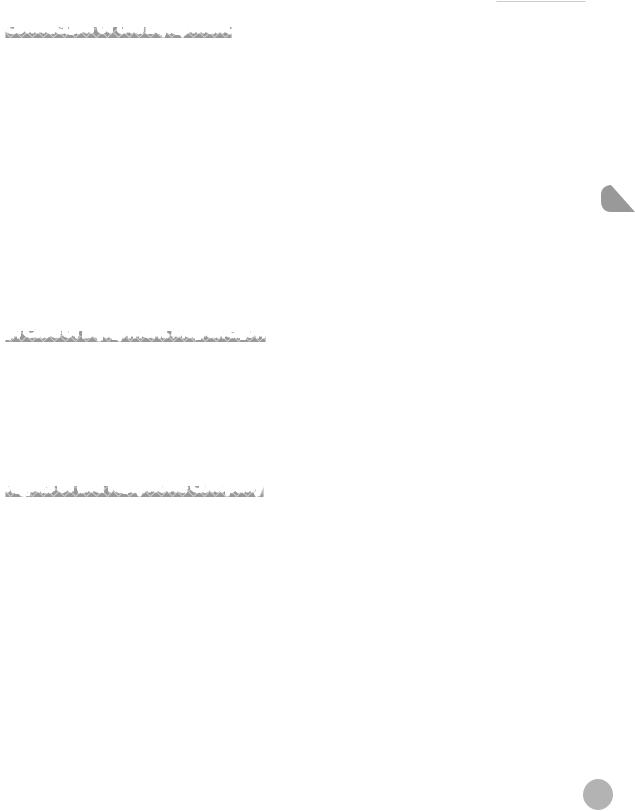
Users in the U.S.A.
Connection of the Equipment |
This equipment complies with Part 68 of the FCC rules and the requirements adopted by the ACTA. On the rear panel of this equipment is a label that contains, among other information, a product identifier in the format US:AAAEQ##TXXXX. If requested, this number must be provided to the telephone company.
An FCC compliant telephone cord and modular jack are provided with this equipment. This equipment is designed to be connected to the telephone network or premises wiring using a compatible modular jack which is Part 68 compliant. See the Starter Guide for details.
The Ringer Equivalence Number (REN) is used to determine the number of devices that may be connected to a telephone line. Excessive RENs on a telephone line may result in the devices not ringing in response to an incoming call. In most but not all areas, the sum of RENs should not exceed five (5.0). To be certain of the number of devices that may be connected to a line, as determined by the total RENs, contact the local telephone company. The REN for this product is part of the product identifier that has the format US: AAAEQ##TXXXX. The digits represented by ## are the REN without a decimal point (e.g., 10 is a REN of 1.0). This equipment may not be used on coin service provided by the telephone company.
Connection to party lines is subjected to state tariffs.
In Case of Equipment Malfunction |
Should any malfunction occur which cannot be corrected by the procedures described in this guide, disconnect the equipment from the telephone line, unplug the network cable (if connected), and unplug the power cord. The telephone line should not be reconnected or the power cord plugged in until the problem is completely resolved. Users should contact Canon Authorized Service Facilities for servicing of equipment. Information regarding Authorized Service Facility locations can be obtained by calling Canon Customer Care Center (1-800-828-4040).
Rights of the Telephone Company
Should the equipment cause harm to the telephone network, the telephone company may temporarily disconnect service. The telephone company also retains the right to make changes in facilities and services which may affect the operation of this equipment. When such changes are necessary, the telephone company is required to give adequate prior notice to the user.
.A.S.U the in Users
xix

.A.S.U the in Users
Users in the U.S.A.
FCC Notice
Color imageCLASS MF9170c/MF9150c/MF8450c: F151100
This device complies with Part 15 of the FCC Rules. Operation is subject to the following two conditions:
(1)This device may not cause harmful interference, and
(2)this device must accept an interference received, including interference that may cause undesired operation.
This equipment has been tested and found to comply with the limits for a class B digital device, pursuant to Part 15 of the FCC Rules. These limits are designed to provide reasonable protection against harmful interference in a residential installation. This equipment generates, uses and can radiate radio frequency energy and, if not installed and used in accordance with the instructions, may cause harmful interference to radio communications. However, there is no guarantee that interference will not occur in a particular installation. If this equipment does cause harmful interference to radio or television reception, which can be determined by turning the equipment off and on, the user is encouraged to try to correct the interference by one or more of the following measures:
•Reorient or relocate the receiving antenna.
•Increase the separation between the equipment and receiver.
•Connect the equipment into an outlet on a circuit different from that to which the receiver is connected.
•Consult the dealer or an experienced radio/TV technician for help.
Use of shielded cable is required to comply with class B limits in Subpart B of Part 15 of FCC Rules.
Do not make any changes or modifications to the equipment unless otherwise specified in this manual. If such changes or modifications should be made, you could be required to stop operation of the equipment.
Canon U.S.A., Inc.
One Canon Plaza, Lake Success, NY 11042, U.S.A.
TEL No. 1-516-328-5600
The Telephone Consumer Protection Act of 1991 makes it unlawful for any person to use a computer or other electronic device to send any message via a telephone fax machine unless such message clearly contains in a margin at the top or bottom of each transmitted page or on the first page of the transmission, the date and time it is sent and an identification of the business or other entity, or other individual sending the message and the telephone number of the sending machine or such business, other entity, or individual.
In order to program this information into the machine, follow the instructions in the Starter Guide.
xx
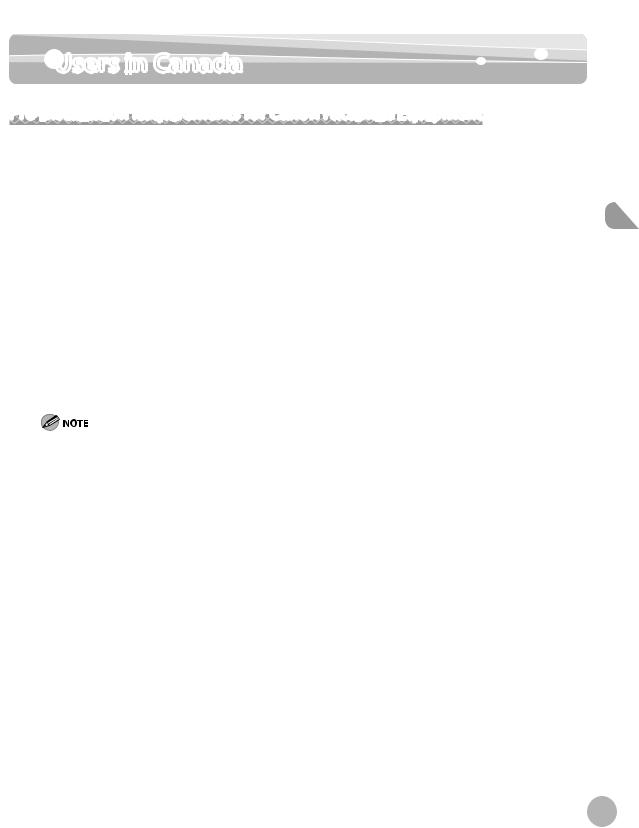
Users in the U.S.A.
 Users in Canada
Users in Canada
Pre-Installation Requirements for Canon Facsimile Equipment |
A. |
Location |
|
|
|
Supply a suitable table, cabinet, or desk. See p. 14-2 for the machine’s weight and dimensions. |
|
|
B. |
Order Information |
|
|
|
1. |
Provide only a single-line to touch-tone or rotary telephone set terminated with a standard 4-pin |
Users |
|
|
modular phone plug. (Touch-tone is recommended if available in your area.) |
|
|
2. |
Order an CA11A modular jack (USOC code), which should be installed by the telephone company. If |
in |
|
.U the |
||
|
|
the CA11A jack is not present, installation cannot occur. |
|
|
3. |
Order a normal business line from your telephone company’s business representative. The line |
.A.S |
|
|
||
should be a regular voice grade line or equivalent. Use one line per machine. DDD (DIRECT DISTANCE DIAL) LINE
-or-
IDDD (INTERNATIONAL DIRECT DISTANCE DIAL) LINE IF YOU COMMUNICATE OVERSEAS
Canon recommends an individual line following industry standards, e.g., the 2500 (touch tone) or 500 (rotary/pulse dial) telephones. A dedicated extension off a PBX machine without “Camp On” signals is also permissible with the machine. Key telephone systems are not recommended because they send non-standard signals to individual telephones for ringing and special codes, which may cause a fax error.
C.Power Requirements
The power outlet should be a three-prong grounded receptacle (Single or Duplex). It should be independent from copiers, heaters, air conditioners or any electric equipment that is thermostatically controlled. The rated value is 120 volts and 15 amperes. The CA11A modular jack should be relatively close to the power outlet to facilitate installation.
xxi

.A.S.U the in Users
Users in the U.S.A.
Notice
This equipment meets the applicable Industry Canada Terminal Equipment Technical Specifications. This is confirmed by the registration number. The abbreviation, IC, before the registration number signifies that registration was performed based on a Declaration of Conformity indicating that Industry Canada technical specifications were met. It does not imply that Industry Canada approved the equipment.
Cet appareil est conforme aux Spécifications techniques des équipements terminaux de I’lndustrie du Canada. Ceci est confirmé par le numéro d’enregistrement. L’abréviation IC précédant le numéro d’enregistrement signifie que I’enregistrement a été effectué sur la base de la Déclaration de conformité indiquant que le produit est conforme aux spécifications techniques du Canada. Ceci n’implique pas que le produit ait été approuvé par I’industrie du Canada.
Before installing this equipment, users should ensure that it is permissible to be connected to the facilities of the local telecommunications company. The equipment must also be installed using an acceptable method of connection. The customer should be aware that compliance with the above conditions may not prevent degradation of service in some situations.
Repairs to certified equipment should be coordinated by a representative designated by the supplier. Any repairs or alterations made by the user to this equipment, or equipment malfunctions, may give the telecommunications company cause to request the user to disconnect the equipment.
Users should ensure for their own protection that the electrical ground connections of the power utility, telephone lines and internal metallic water pipe system, if present, are connected together. This precaution may be particularly important in rural areas.
Users should not attempt to make such connections themselves, but should contact the appropriate electric inspection authority, or electrician, as appropriate.
This Class B digital apparatus meets all requirements of the Canadian InterferenceCausing Equipment Regulations. Cet appareil numérique de la classe B respecte toutes les exigences du Règlement sur le matériel brouilleur du Canada.
xxii

Users in the U.S.A.
The Ringer Equivalence Number (REN) for this terminal equipment is 1.0. The REN assigned to each terminal equipment provides an indication of the maximum number of terminals allowed to be connected to a telephone interface. The termination on an interface may consist of any combination of devices subject only to the requirement that the sum of the Ringer Equivalence Numbers of all the devices does not exceed five. Le Nombre d’équivalence Ringer (REN) de cet appareil terminal est 1.0. Le REN attribué à chaque équipement terminal fournit une indication sur le nombre maximum de terminaux pouvant être connectés sur une interface téléphonique. La terminaison sur une interface peut consister en n’importe quelle combinaison d’appareils, à la condition seulement que la somme des Nombres d’équivalence Ringer de tous les appareils ne soit pas supérieure à 5.
CANON CANADA INC. 1-800-652-2666
9 A.M. to 8 P.M. EST Monday through Friday (excluding holidays)
.A.S.U the in Users
xxiii
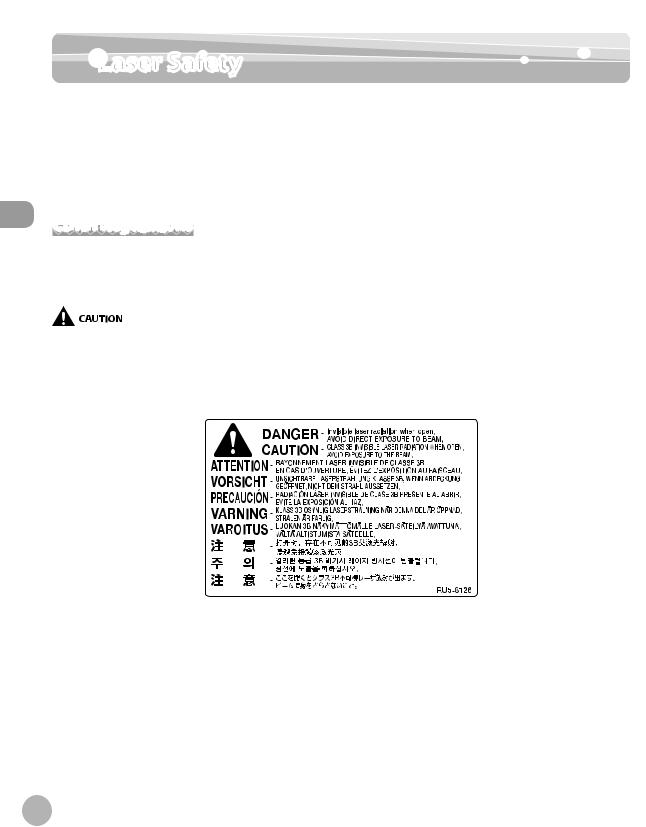
Safety Laser
Laser Safety
 Laser Safety
Laser Safety
This machine complies with 21 CFR Chapter 1 Subchapter J as a Class 1 laser product under the U.S. Department of Health and Human Services (DHHS) Radiation Performance Standard according to the Radiation Control for Health and Safety Act of 1968. This means that the machine does not produce hazardous radiation.
Since radiation emitted inside the machine is completely confined within protective housings and external covers, the laser beam cannot escape from the machine during any phase of user operation.
CDRH Regulations |
The Center for Devices and Radiological Health (CDRH) of the U.S. Food and Drug Administration implemented regulations for laser products on August 2, 1976. These regulations apply to laser products manufactured from August 1, 1976. Compliance is mandatory for products marketed in the United States.
Use of controls, adjustments, or performance of procedures other than those specified in this manual may result in hazardous radiation exposure.
The label is attached to the laser scanner machine inside the machine and is not in a user access area.
xxiv
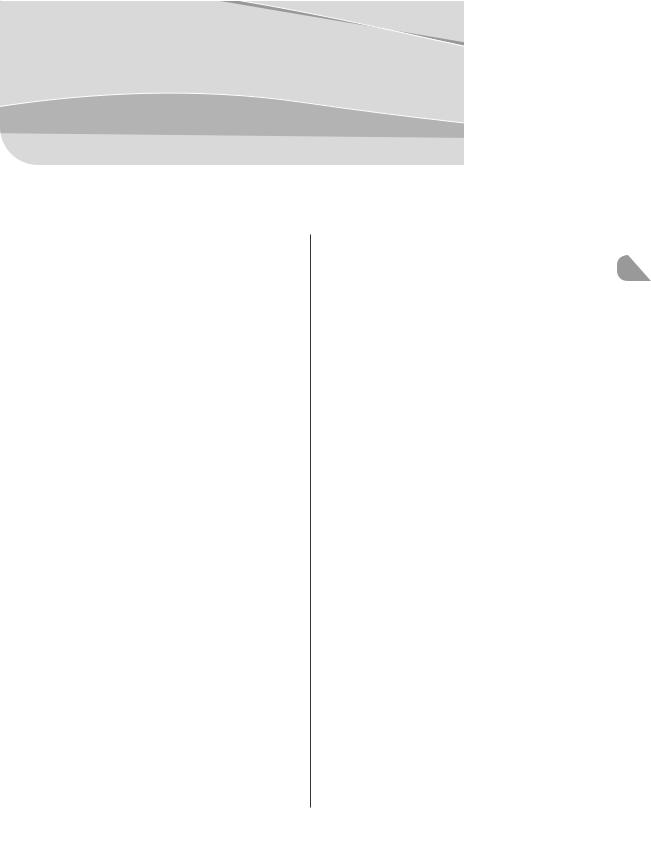
|
|
|
1 |
|
Before Using the |
|
|
|
|
Machine |
|
Chapter |
|
|
|
|
|
|
|
|
|
|
|
|
|
|
|
|
|
This chapter describes what you should know before using this machine, such as the names of the parts and their functions, and how to set up the machine to send/receive faxes.
Machine Components.................................................. |
1-2 |
External View (Front)........................................................... |
1-2 |
External View (Back)............................................................ |
1-4 |
Internal View.......................................................................... |
1-5 |
Control Panel................................................................ |
1-6 |
Main Control Panel.............................................................. |
1-6 |
Registering the Custom Keys........................................... |
1-8 |
Left Side of the Control Panel....................................... |
1-10 |
Right Side of the Control Panel.................................... |
1-10 |
Display Parts and Functions...................................... |
1-11 |
Main Menu Screen............................................................ |
1-11 |
Copy Top Screen................................................................ |
1-12 |
Send Type Selection Screen.......................................... |
1-13 |
Store Type Selection Screen.......................................... |
1-14 |
Select Memory Media Screen |
|
(Color imageCLASS MF9170c/9150c Only).............. |
1-14 |
Log In Mode........................................................................ |
1-14 |
Toner Cartridges......................................................... |
1-15 |
Maintaining the Toner Cartridges............................... |
1-16 |
Checking the Toner Level............................................... |
1-17 |
Checking the Device Information............................. |
1-18 |
Entering Characters................................................... |
1-19 |
Telephone Line Setting.............................................. |
1-20 |
Timer Settings............................................................ |
1-22 |
Setting the Sleep Mode.................................................. |
1-22 |
Setting Auto Clear Time.................................................. |
1-23 |
Setting the Daylight Saving Time................................ |
1-24 |
Machine the Using Before
1-1
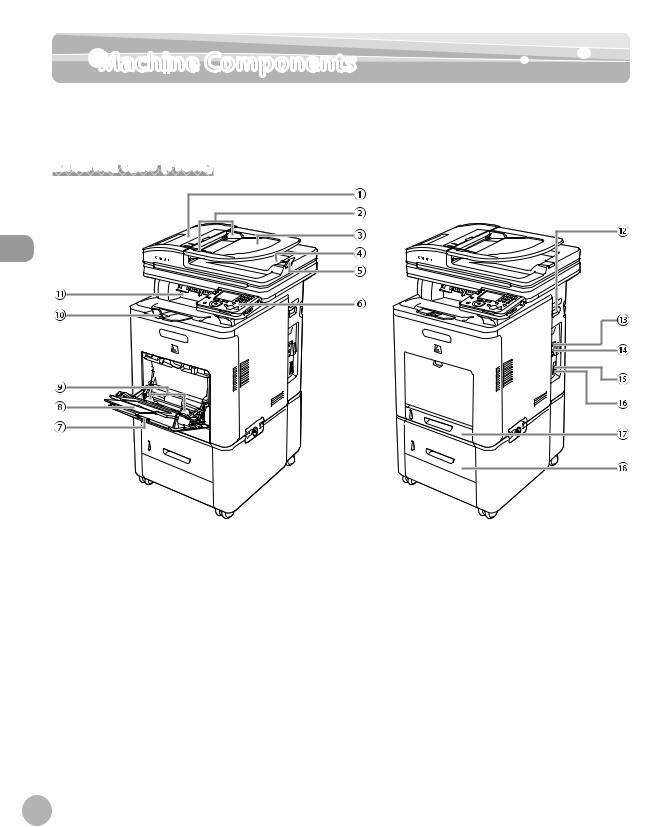
Machine Components
 Machine Components
Machine Components
This section describes the names and functions of all the parts on the outside and inside of the machine.
External View (Front) |
Machine the Using Before
1-2

Feeder
Originals placed in the Feeder are automatically fed sheet by sheet to the scanning area. The feeder also automatically turns over two-sided originals to make oneor two-sided copies.
Slide Guides
Adjust the slide guides to match the width of the originals.
Original Supply Tray
Originals placed here are automatically fed sheet by sheet to the scanning area of the platen glass. Place originals into this tray with the surface that you want to scan face up.
Original Output Tray
Originals that have been scanned from the original supply tray are output to the original output tray in the order that they are fed into the feeder.
Original Stopper
Prevents the originals from falling off the paper delivery tray.
Open the stopper from its original position for LTR/A4 size paper. For LGL size paper, pull out the extension first, and then open the stopper.
Control Panel Machine controls.
Stack Bypass Tray
Feeds non-standard size or thick/thin type paper stacks.
Stack Bypass Tray Extension Pull out to load paper stack.
Slide Guides for Stack Bypass Tray Adjusts to the width of the paper.
Machine Components
Paper Stopper
Prevents the paper from falling off the paper delivery tray.
Open the stopper from its original position for LTR/A4 size paper. For LGL size paper, pull out the extension first, and then open the stopper.
Paper Delivery Tray
Copies, prints and faxes are output to the paper delivery tray.
Main Power Switch
Press to the “I” side to turn the power ON.
USB Port
Connect the USB (Universal Serial Bus) cable.
Ethernet Port
Connect the network cable.External Device Jack
Connect an external device.
Telephone Line Jack
Connect the external telephone cable.
Paper Drawer
Holds up to 250 sheets of paper (20 lb (75 g/m2)).Optional Cassette Feeding Unit-AC1
Holds the additional paper supply. Up to 500 sheets of paper (20 lb (75 g/m2)) can be held.
Machine the Using Before
1-3

Machine Components
External View (Back) |
Machine the Using Before
Back Cover
Open this cover to clear paper jams.
Power Socket
Connect the power cord.
1-4

Machine Components
Internal View
Machine the Using Before
Scanning Area
Originals placed in the feeder are scanned here.
Platen Glass
Place originals here when scanning books, thick originals, thin originals, transparencies, etc.
Toner Cartridges
When toner runs out, pull out the empty toner cartridges, and replace them with new ones.
Delivery Feeder Unit (Electrostatic Transfer Belt) Transfers toner to paper. Do not place any objects on or touch the transfer belt. Doing so deteriorates print quality.
Front Cover
Open this cover to replace the toner cartridges or to clear paper jams.
Duplex Unit
The duplex unit enables you to use the 2-Sided mode for copying or printing.
Fixing Unit
The fixing unit fixes the toner to the paper. The parts inside the fixing unit are subject to high temperatures. When removing jammed paper, take care not to touch anything in this area.
1-5
